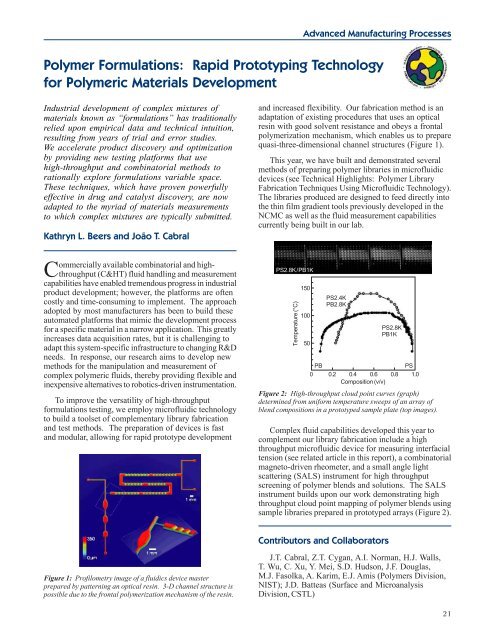Materials Science and Engineering Laboratory FY 2004 ... - NIST
Materials Science and Engineering Laboratory FY 2004 ... - NIST
Materials Science and Engineering Laboratory FY 2004 ... - NIST
You also want an ePaper? Increase the reach of your titles
YUMPU automatically turns print PDFs into web optimized ePapers that Google loves.
Advanced Manufacturing Processes<br />
Polymer Formulations: Rapid Prototyping Technology<br />
for Polymeric <strong>Materials</strong> Development<br />
Industrial development of complex mixtures of<br />
materials known as “formulations” has traditionally<br />
relied upon empirical data <strong>and</strong> technical intuition,<br />
resulting from years of trial <strong>and</strong> error studies.<br />
We accelerate product discovery <strong>and</strong> optimization<br />
by providing new testing platforms that use<br />
high-throughput <strong>and</strong> combinatorial methods to<br />
rationally explore formulations variable space.<br />
These techniques, which have proven powerfully<br />
effective in drug <strong>and</strong> catalyst discovery, are now<br />
adapted to the myriad of materials measurements<br />
to which complex mixtures are typically submitted.<br />
Kathryn L. Beers <strong>and</strong> João T. Cabral<br />
Commercially available combinatorial <strong>and</strong> highthroughput<br />
(C&HT) fluid h<strong>and</strong>ling <strong>and</strong> measurement<br />
capabilities have enabled tremendous progress in industrial<br />
product development; however, the platforms are often<br />
costly <strong>and</strong> time-consuming to implement. The approach<br />
adopted by most manufacturers has been to build these<br />
automated platforms that mimic the development process<br />
for a specific material in a narrow application. This greatly<br />
increases data acquisition rates, but it is challenging to<br />
adapt this system-specific infrastructure to changing R&D<br />
needs. In response, our research aims to develop new<br />
methods for the manipulation <strong>and</strong> measurement of<br />
complex polymeric fluids, thereby providing flexible <strong>and</strong><br />
inexpensive alternatives to robotics-driven instrumentation.<br />
To improve the versatility of high-throughput<br />
formulations testing, we employ microfluidic technology<br />
to build a toolset of complementary library fabrication<br />
<strong>and</strong> test methods. The preparation of devices is fast<br />
<strong>and</strong> modular, allowing for rapid prototype development<br />
Figure 1: Profilometry image of a fluidics device master<br />
prepared by patterning an optical resin. 3-D channel structure is<br />
possible due to the frontal polymerization mechanism of the resin.<br />
<strong>and</strong> increased flexibility. Our fabrication method is an<br />
adaptation of existing procedures that uses an optical<br />
resin with good solvent resistance <strong>and</strong> obeys a frontal<br />
polymerization mechanism, which enables us to prepare<br />
quasi-three-dimensional channel structures (Figure 1).<br />
This year, we have built <strong>and</strong> demonstrated several<br />
methods of preparing polymer libraries in microfluidic<br />
devices (see Technical Highlights: Polymer Library<br />
Fabrication Techniques Using Microfluidic Technology).<br />
The libraries produced are designed to feed directly into<br />
the thin film gradient tools previously developed in the<br />
NCMC as well as the fluid measurement capabilities<br />
currently being built in our lab.<br />
Figure 2: High-throughput cloud point curves (graph)<br />
determined from uniform temperature sweeps of an array of<br />
blend compositions in a prototyped sample plate (top images).<br />
Complex fluid capabilities developed this year to<br />
complement our library fabrication include a high<br />
throughput microfluidic device for measuring interfacial<br />
tension (see related article in this report), a combinatorial<br />
magneto-driven rheometer, <strong>and</strong> a small angle light<br />
scattering (SALS) instrument for high throughput<br />
screening of polymer blends <strong>and</strong> solutions. The SALS<br />
instrument builds upon our work demonstrating high<br />
throughput cloud point mapping of polymer blends using<br />
sample libraries prepared in prototyped arrays (Figure 2).<br />
Contributors <strong>and</strong> Collaborators<br />
J.T. Cabral, Z.T. Cygan, A.I. Norman, H.J. Walls,<br />
T. Wu, C. Xu, Y. Mei, S.D. Hudson, J.F. Douglas,<br />
M.J. Fasolka, A. Karim, E.J. Amis (Polymers Division,<br />
<strong>NIST</strong>); J.D. Batteas (Surface <strong>and</strong> Microanalysis<br />
Division, CSTL)<br />
21

















